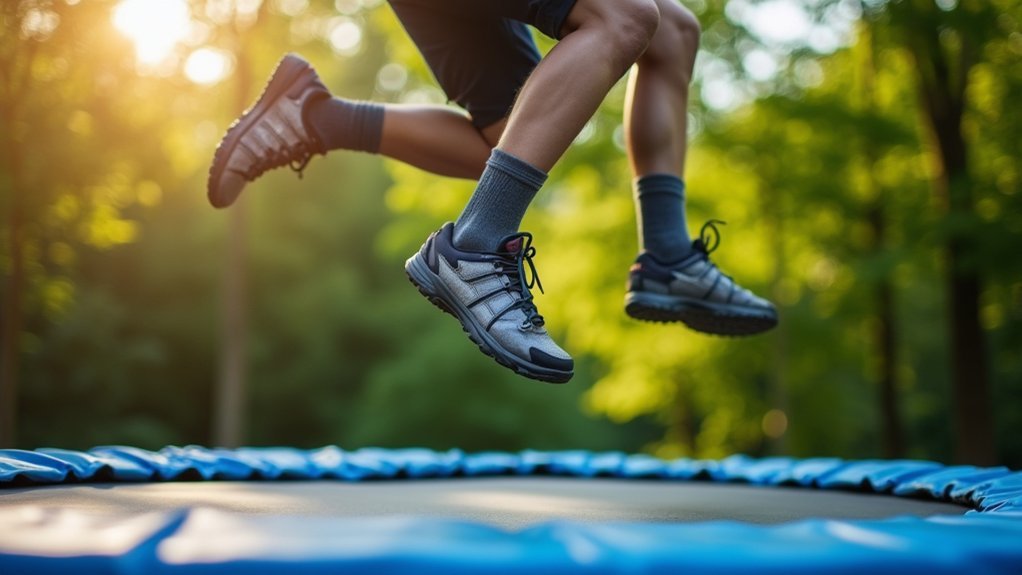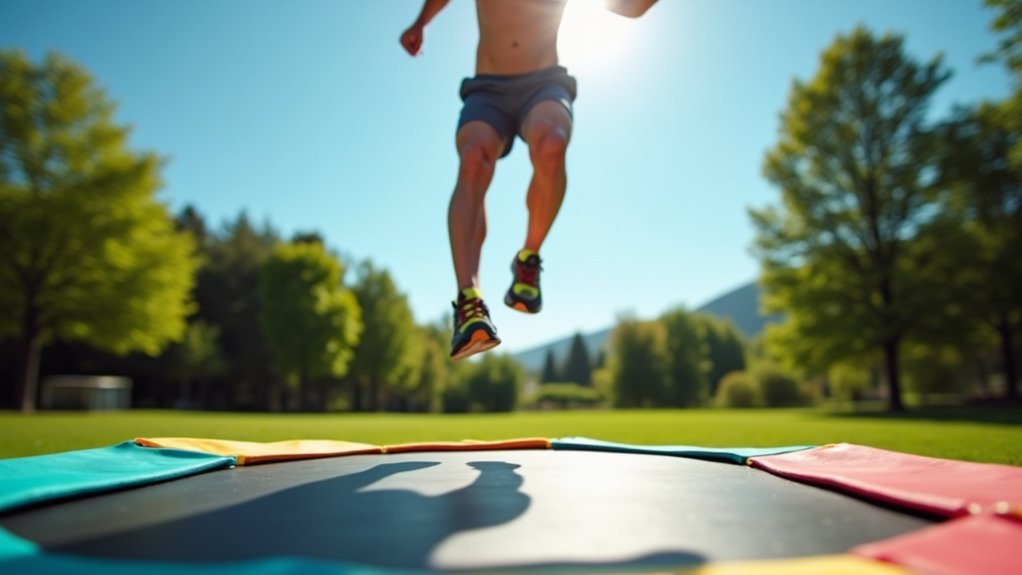Strengthen your ankles on a trampoline with ten effective exercises: basic jumps, single-leg hops, lateral jumps, heel-toe bounces, 180-degree turns, tuck jumps, micro-hops, weighted pogo jumps, rotational movements, and balance challenges with eyes closed. These low-impact exercises build stability, improve coordination, and reduce injury risk while engaging multiple muscle groups. Proper progression from basic to complex movements guarantees safe, effective training for ankle strength and overall performance improvement.
10 Best Trampoline Exercises For Stronger Ankles

While traditional strength training often overlooks ankle development, trampoline exercises provide an ideal platform for building ankle strength and stability.
Start with targeted heel-toe bounces to adapt neuromuscular pathways without complex movements.
Progress to slow-motion micro-hops focusing on midfoot landings to improve ankle dorsiflexion control.
Incorporate weighted pogo jumps using 1-3lb ankle weights for explosive power development, minimizing knee bend to isolate plantarflexion strength.
Challenge yourself with unstable surface progressions by placing Bosu balls on the trampoline or adding texture variations with foam pads. For an additional stability challenge, try lateral hopping exercises which enhance coordination while preventing re-injury during rehabilitation.
Try single-limb catching drills while maintaining continuous micro-bounces to enhance dynamic balance.
For advanced training, integrate plyometric elements like depth jumps or drop-and-stop landings with emphasis on silent foot contact.
Single-Leg Bounce Progression for Lateral Stability
Building on our earlier ankle-strengthening exercises, single-leg bounce progressions specifically target lateral stability—an often neglected but essential component of ankle health.
By mastering these movements, you’ll enhance your proprioception and develop resilient ankles for any lateral movements in sports or daily activities.
- Start with basics – Begin in a single-leg stance for 60 seconds before attempting bounces. Engage your core and maintain proper alignment with your knee tracking over your foot.
- Add lateral movement – Progress to gentle side-to-side hops, focusing on soft landings on the ball of your foot while maintaining balance. This movement pattern effectively replicates daily life movements that require lateral agility and stability.
- Increase complexity – Once comfortable, introduce obstacles like small cones alongside your trampoline or vary your bounce height to challenge stability further.
Balance Challenge: Eyes-Closed Stance Variations

Taking your balance training to the next level requires closing your eyes, which instantly transforms even simple trampoline stances into powerful ankle-strengthening exercises. Your body must rely solely on proprioception, dramatically increasing core and ankle muscle engagement.
Begin with a basic stance, feet shoulder-width apart, eyes open until you’re comfortable with the trampoline’s surface. Then close your eyes for 15-30 seconds, gradually increasing duration as your stability improves. For additional challenge, try performing this exercise while standing on a foam pad to further destabilize your position.
For progressive difficulty, try narrowing your stance, shifting to a single-leg position, or adding gentle arm movements. These variations challenge different muscle groups while enhancing your overall stability.
This training improves your adaptability to uneven surfaces, reducing injury risk in daily activities and sports by strengthening the vital connection between your core and ankles.
Rapid-Fire Pogo Hops for Tendon Resilience
Rapid-fire pogo hops represent one of the most effective trampoline exercises for developing resilient ankle tendons and explosive power.
Maintain a stiff-knee posture with slight bend while explosively pushing off the balls of your feet. Focus on minimizing ground contact time to under 0.2 seconds per hop, stimulating fast reactive tension in your ankle muscles. This exercise subjects your ankles to increased impact forces, helping strengthen the supporting structures needed for stability.
Stiff knees, quick feet. Explode upward with lightning-fast contacts to train those ankle tendons for maximum spring.
- Progressive loading: Start with bodyweight hops, then add light dumbbells (2-5 lbs) or a weight vest (5-10% bodyweight) to increase tendon adaptation.
- Form priority: Monitor knee-over-toe alignment and terminate sets when hop height decreases.
- Sport-specific variations: Incorporate directional changes (diagonal/rotational) to simulate basketball cuts, gymnastics takeoffs, or running mechanics.
Perform 10 consecutive hops per set with a controlled “stick” landing on your final repetition.
Rotational Surf Twists for Multi-Directional Strength

Rotational surf twists on the trampoline strengthen your ankles in multiple planes of movement, mimicking the dynamic demands of board sports and everyday activities.
You’ll build resilience against unexpected lateral forces while preparing your joints for quick directional changes that often lead to sprains.
As you twist through these controlled movements, you’re teaching your ankles to maintain stability under rotation—creating natural protection far more effective than supportive braces. Similar to surf training techniques, these exercises should prioritize body awareness rather than speed or power for optimal joint conditioning.
Maximize Stability Through Rotation
While traditional ankle exercises often focus on up-and-down movements, your ankles need multi-directional strength to truly excel in dynamic activities like surfing.
The trampoline provides an ideal low-impact environment to develop rotational stability that connects directly to your core strength.
- Rotational Jumps – Start with small jumps while rotating your ankles clockwise, then counterclockwise, gradually increasing the rotation range to strengthen lateral muscles.
- Surf Twists – Jump slightly upward, twist your lower body 45-90 degrees while keeping your upper body facing forward, then land softly to mimic the rotational demands of surfing. These exercises help improve proprioception and balance which are essential components in preventing ankle injuries while surfing.
- Oblique Bounces – Stand with feet shoulder-width apart, bouncing while engaging your core and slightly rotating your ankles with each landing.
Prevent Ankle Sprains Naturally
Although ankle sprains can sideline even the most experienced surfers, trampoline-based rotational exercises offer a powerful defense against these common injuries.
By incorporating rotational drills that mimic surfing movements, you’ll strengthen your ankles in multiple directions simultaneously.
Start with simple ankle circles while bouncing gently, then progress to more dynamic surf-type twists where you rotate your body mid-bounce. These movements train your ankles to respond to unpredictable forces—just like they need to on a surfboard. Performing these exercises enhances proprioception and awareness when riding waves.
Combine these exercises with trampoline landings that challenge your balance and stability. For added protection, consider ankle taping during high-intensity sessions.
The multi-directional training on a trampoline’s unstable surface prepares your ankles for the real-world demands of surfing while naturally building resilience against sprains.
Scissor Jumps to Enhance Ankle Adaptability
Scissor jumps represent one of the most effective trampoline exercises for developing ankle adaptability due to their unique combination of explosive power and mid-air shift demands.
Starting from a staggered lunge position, you’ll explosively propel upward, switch legs mid-air, and land with control—all while your ankles work overtime to stabilize each changeover. The exercise engages multiple muscle groups including your calves which directly contribute to ankle strength and stability.
- Progressive Implementation – Begin with 2-3 sets of 5-8 reps on your trampoline’s stable center, gradually increasing volume as your ankle stability improves.
- Form Focus – Maintain an upright torso throughout the movement and absorb landings through the balls of your feet with slight knee flexion.
- Recovery Timing – Allow 48 hours between sessions to optimize the ankle-strengthening adaptations in lateral stability and reactive capability.
High-Knee Pulls for Unilateral Ankle Control
High-knee pulls transform your ankle stability approach by isolating each foot’s performance individually. This exercise mimics sprinting mechanics while engaging your hip flexors, glutes, and calves to enhance proprioception and dorsiflexion control.
Stand tall with your core engaged, then drive one knee toward your chest while keeping the lifted foot dorsiflexed. Lower with controlled motion to maximize eccentric strength development in your ankle stabilizers. Consistent practice of this exercise helps prevent ankle injuries that are common in high-impact sports.
| Aspect | Common Error | Correction |
|---|---|---|
| Posture | Leaning backward | Maintain upright torso |
| Foot Position | Pointing toes down | Pull toes toward shin |
| Tempo | Rushing descent | Control lowering phase |
| Support | Pelvic rotation | Engage core stability |
| Progression | Using flat surface only | Add foam pad for challenge |
Perform 2-3 sets of 8-12 reps per leg, 2-3 times weekly for ideal ankle development.
Heel-to-Toe Rocking for Improved Proprioception
Balancing on a trampoline while shifting your weight from heel to toe creates an exceptional proprioceptive challenge that strengthens your ankles from multiple angles. This rocking motion enhances your body’s awareness of position and movement, which naturally declines with age.
The trampoline’s unstable surface intensifies the exercise, forcing your ankles to work harder to maintain stability. The exercise engages the peripheral mechanoreceptors in your feet, ankles, and leg muscles that are essential for detecting position changes.
- Start slowly, standing with feet hip-width apart, then gradually rock from heels to toes while maintaining balance.
- Try wearing minimalist footwear during practice to maximize sensory feedback and foot activation.
- Combine with other balance exercises like single-leg stands or BOSU ball work for thorough proprioceptive training.
This simple yet effective exercise reduces fall risk while improving coordination and ankle strength with consistent practice.
Figure-Eight Bounces for Coordination Training
While traditional ankle strengthening often focuses on static exercises, figure-eight bounces on a trampoline create dynamic challenges that dramatically improve coordination and stability.
These movements engage your core while forcing continuous weight shifts between legs, challenging ankle stabilizers dynamically. For proper form, shift your weight into your heels while keeping the balls of feet on the trampoline.
As you perform figure-eights, your ankles make rapid micro-adjustments in dorsiflexion and plantarflexion angles.
The trampoline’s unstable surface amplifies proprioception compared to floor drills, while multidirectional forces engage lateral muscles to prevent rolling.
Start with a static position holding a stability bar before attempting full figure-eights.
Wear grippy socks to prevent slippage, and limit sessions to under 5 minutes if you’re a beginner.
For added challenge, incorporate weighted dodgeballs or resistance bands to increase proprioceptive demands.
Controlled Edge Rebounds for Inversion Strength
You’ll gain exceptional inversion strength by mastering outer-edge landing techniques on your trampoline, which specifically target those ankle muscles most vulnerable to sprains.
Start with single-foot touches on the outer edge, maintaining contact for three seconds before returning to center position. As your stability improves, challenge yourself by performing small controlled jumps along the perimeter, gradually increasing height while maintaining proper ankle alignment. Always ensure your trampoline is set up on a flat, non-slippery surface to prevent accidents and maximize the effectiveness of these ankle-strengthening exercises.
Outer-Edge Landing Techniques
Three essential outer-edge landing techniques can dramatically improve your ankle inversion strength on a trampoline.
By practicing these controlled movements, you’ll train your ankles to absorb and redirect force while maintaining proper alignment throughout your body. Always keep a straight back when performing these exercises, similar to the body positioning taught in table drop techniques.
- Straight Posture Rebounds – Keep your core engaged and spine aligned while performing gentle bounces on the outer edge. This builds foundational stability while strengthening the lateral ankle muscles.
- Progressive Edge Drops – Start with small seat drops landing slightly on the outer edge, gradually increasing height as your confidence grows. Focus on even weight distribution and proper leg absorption.
- Edge-to-Center Shifts – Practice landing on the outer edge before smoothly shifting to center landings, engaging your ankle muscles throughout the movement while maintaining core stability.
Progressive Stability Challenges
Once you’ve mastered basic outer-edge techniques, progressive stability challenges can greatly enhance your ankle inversion strength. Rebounding on the trampoline’s edge specifically targets these essential muscles while improving balance and response time.
Begin with controlled edge rebounds at a comfortable height, gradually increasing intensity as your confidence builds. Focus on precision rather than height to avoid overuse injuries. These exercises directly strengthen the inversion muscles that stabilize your ankles during lateral movements.
For maximum benefit, incorporate single-leg balance holds between rebounds to increase proprioceptive demands. This combination improves neuromuscular coordination and functional stability. This approach resembles the ankle strengthening exercises that showed significant improvements in ankle stability for young females with chronic instability.
You’ll notice enhanced control during everyday activities and athletic movements alike.
Remember to adjust the rebound height and frequency according to your individual needs, ensuring a safe progression that challenges without overwhelming your ankles.
Frequently Asked Questions
How Long Before Ankle Strength Improvements Become Noticeable?
You’ll typically notice initial ankle strength improvements in 4-6 weeks as neuromuscular adaptations develop. More significant strength gains become measurable after 6-8 weeks of consistent training with proper intensity and progression.
Can Seniors Safely Perform These Trampoline Exercises?
Yes, you can safely perform these exercises if you’re a senior. Start with gentle bouncing, use proper equipment, consider having a partner nearby, and progress gradually as your balance and strength improve.
Are Mini Trampolines as Effective as Full-Sized Ones?
Mini trampolines can be as effective as full-sized ones for ankle strengthening. You’ll get similar benefits with less impact, though you’ll have limited space for variety in your movements and exercises.
How Do I Prevent Ankle Pain During Trampoline Exercises?
To prevent ankle pain during trampoline exercises, you’ll need to warm up properly, wear supportive footwear, jump with bent knees, and maintain correct foot positioning. Don’t forget to strengthen surrounding muscles between sessions.
Should I Wear Shoes or Go Barefoot for Ankle Strengthening?
For ankle strengthening, barefoot is better as it enhances proprioception and activates smaller muscles. However, start with shoes if you’re uncomfortable, then gradually shift to barefoot as your stability improves.
In Summary
You’ve now got 10 powerful exercises to strengthen your ankles on the trampoline. By incorporating these movements into your routine just 2-3 times weekly, you’ll build more resilient joints and improve your balance. Don’t rush the progression—start with basics and advance as your stability improves. Your ankles support every step you take, so this small time investment will benefit your overall fitness journey tremendously.





Leave a Reply